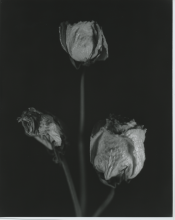So I'm trying to keep my darkroom system very minimal because i don't have a dedicated space. I'm printing with xtol because I have a history skin allergies, I'm sure tf-5 isn't great health wise but I'm doing what I can. I'd like to have just one developer to deal with, I'm on septic system and nothing goes down the drain except rinse water.
I just wanted to throw out a few questions and see if anyone can spot any flaws in my system before i get stuck in a routine. Keep in mind I'm using beseler developing drums, 8x10 and 11x14 on a uniroller base.
1. Xtol - I'm prepared for longer times and some testing and planning on using this as one shot.
2. Distilled water stop, one shot. I've read alot about tf-5 and a running water stop, drums make that impossible, does it have more to do with build up of developer in your stop tray, or something else? Am I good with my method or do I need a different approach?
3. Tf-5 fix, I've yet to use this fixer, and maybe I'm reading the mixing instructions wrong but it looks to me that it can be measured and mixed as needed from the bottle of concentrate vs mixing the entire 1 liter bottle to make a gallon of fixer, please correct me if I'm wrong.
4. Wash in tray in sink. I don't have a print washer yet so this step is pretty straight forward.
That's pretty much it, just covering my bases any input is greatly appreciated.
I just wanted to throw out a few questions and see if anyone can spot any flaws in my system before i get stuck in a routine. Keep in mind I'm using beseler developing drums, 8x10 and 11x14 on a uniroller base.
1. Xtol - I'm prepared for longer times and some testing and planning on using this as one shot.
2. Distilled water stop, one shot. I've read alot about tf-5 and a running water stop, drums make that impossible, does it have more to do with build up of developer in your stop tray, or something else? Am I good with my method or do I need a different approach?
3. Tf-5 fix, I've yet to use this fixer, and maybe I'm reading the mixing instructions wrong but it looks to me that it can be measured and mixed as needed from the bottle of concentrate vs mixing the entire 1 liter bottle to make a gallon of fixer, please correct me if I'm wrong.
4. Wash in tray in sink. I don't have a print washer yet so this step is pretty straight forward.
That's pretty much it, just covering my bases any input is greatly appreciated.












